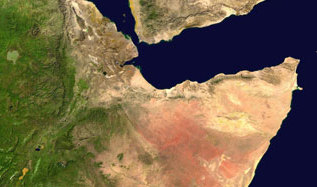PBS: Escaping Eritrea … [Read More...] about ካብ ውሽጢ ቤት ማእሰርታት ኤርትራ
The Parasite That Wires Plants Together
ED YONG |
By draining the fluids from several hosts, dodder vines inadvertently allow plants to communicate with each other and share alarm signals.

It goes by witch’s hair, strangleweed, devil’s gut, wizard’s net, and hellbine. And anyone who sees dodder vines in action will quickly understand why they’ve earned such dastardly, eldritch names. These parasitic plants emerge from the ground as a slender tendril, which sniffs around for chemicals released by potential hosts. When the tendril finds a target, it wraps itself around a stem, grows into it, and, like a vampire, begins to drain its fluids.
From one host, dodder vines can reach many more. In a still photo, a dodder infestation looks like someone has thrown spaghetti over a field or forest. But if you speed up the vines’ movements with a time-lapse camera, they resemble a mass of writhing serpents, thrashing about in their quest for more nutrients. By the time it’s finished, a single dodder vine can connect dozens, perhaps hundreds, of hosts. “In our lab, we could connect at least 100 soybean plants with a dodder seedling,” says Jianqiang Wu from the Chinese Academy of Sciences.
And that, unexpectedly, has its upsides.
Wu’s team has now found that dodder inadvertently wires plants together, allowing them to trade chemical messages that warn one another of attacks by insects.
Plants may seem like passive victims, ready to be easily consumed by hungry animals. But in reality, they actively defend themselves. They can produce defensive toxins when their leaves and stems are attacked. They can communicate with each other by releasing alarm chemicals into the air, which tell neighboring plants to boost their defenses, or which summon parasitic wasps that kill the leaf-eating insects. They can also release different alarm signals throughout their bodies, so that a single assaulted leaf can trigger defenses in every leaf, as well as in roots, stems, and more.
“When it comes to defending against pests, each individual could gain access to the knowledge of the group.”
Wu reasoned that if such alarm signals can travel within a plant, then surely they can travel between plants that are connected by dodder. They could move between the stems of distant individuals by zooming through the parasite that bridges them.
Wu’s colleagues Christian Hettenhausen and Juan Li tested this idea by connecting two soybean plants with dodder, and infesting one of them with caterpillars. The second plant got nary a nibble, but it still switched on hundreds of genes, including many that are involved in anti-insect countermeasures. It still produced higher levels of defensive chemicals. And when it was in turn attacked by caterpillars, it fended them off more effectively than plants that had never been parasitized by dodder.
Dodder can transmit these alarm signals very quickly, in as little as half an hour. It can do so over long distances of 10 meters or more. And it can even successfully wire unrelated species together, like mustard cress and tobacco.
It’s not that dodder has evolved to do this. The parasite is a generalist with unfussy taste in hosts, so it doesn’t really benefit by improving the lives of the plants it attacks. And Wu still suspects that the transmission mechanism does more harm than good, by sapping its hosts of water and nutrients. But it’s perhaps surprising that it does any good at all.
“It’s a very cool study,” says Muvari Connie Tjiurutue from the University of Massachusetts Amherst. By wiring hosts plants together, she says, dodder could change the nature of foods webs, and the relationships within entire communities of plants. When it comes to defending against pests, each individual could gain access to the knowledge of the group, allowing all of them to mount defenses as a unit. “We’re now planning experiments in the field to clarify whether this signaling plays a significant role in nature,” Wu says.
Cuscuta pentagona (dodder) is an obligate parasitic plant that lives by forming connections via haustoria to host plants, in this way satisfying all its water and nutrients needs. To succeed in this parasitic lifestyle, dodder has evolved amazing adaptions to locate and parasitize host plants, some of which are evident in this time-lapse video of dodder interacting with Arabidopsis and Tomato. Our research group at Virginia Tech researches host-parasite interactions. Enjoy! [Cuscuta’s lifestyle reminds one of the relationship between the people and the ruling party!]
